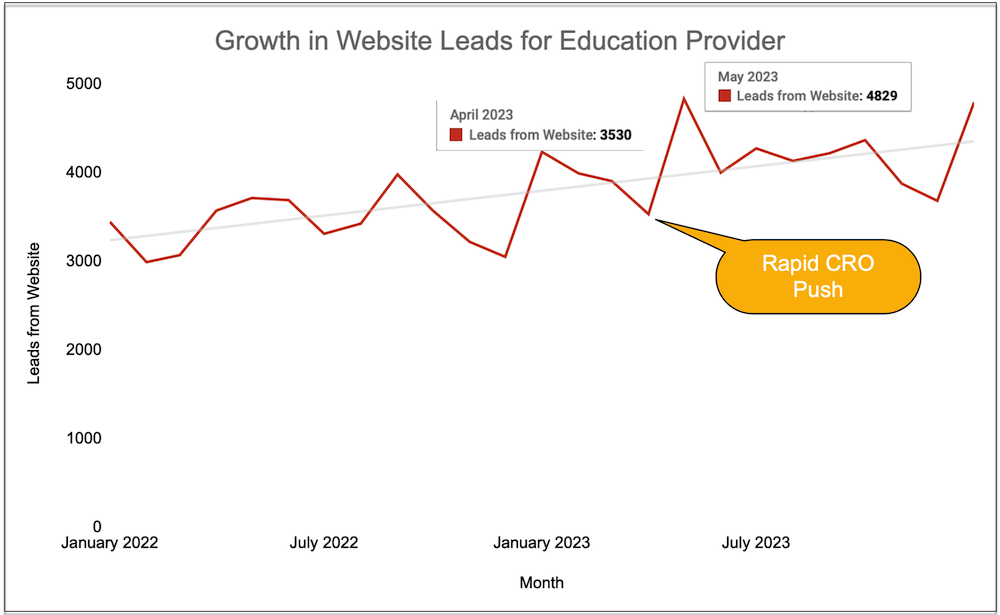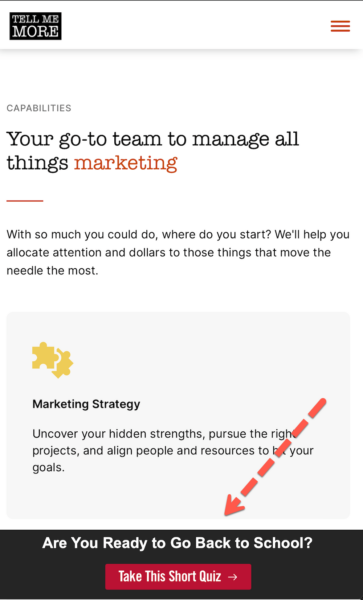In this case study, discover how we implemented a rapid design and deploy sprint to increase month-over-month website leads by 35% for a national education provider and hit their highest-ever yearly lead total.

Our aggressive target for 2023 was 11% percent growth in leads over the prior year and we finished the year with 18% growth in leads as a result of our conversion rate optimization efforts.
The Story: Leads Were Up—But Not as Much as They Could Have Been
The education market is competitive, and attracting prospective students online is key. Our client, a top education provider in their industry, relies on generating qualified leads as these are essential for potential enrollments. Since tuition represents a significant investment, each lead holds the potential to bring significant revenue for our client.
In early 2023, we committed to an aggressive annual lead generation target of 11% growth year-over-year. This seemed quite feasible as we had nearly doubled our lead total for the client the previous year.
We had an excellent first quarter in 2023, easily surpassing our lead target in each of the first three months of the year. But in April, we noticed a problem: leads weren’t increasing as much as they should have been based on traffic trends and fell below target for the first time in three years.
As we dug more into the data, we identified the challenge more clearly:
- We were continuing to bring in leads at a steady pace, but not as much as traffic growth indicated we could be in 2023.
- One of our lead generation channels, email campaigns, were working too well and obscuring the fact that leads coming through the website were not increasing at a comparable rate.
The Strategy—A Rapid-Response, Multi-Faceted CRO Push
First, we researched other contingencies to see if there were external industry-related factors that could account for the stagnant lead growth. Some of the research included looking into trends in Google searches for online education, seasonality of student applications, and the SERP ranking of our most valuable keywords.
That research didn’t turn up any viable explanation for what we were seeing.
With external causes ruled out, we started thinking about solutions.
Our typical approach when deploying new features is to validate them first via an A/B split test. This is the gold standard for proving hypotheses about which solutions will yield results, and it allows us to move forward with a clear idea of what the outcome of our changes will be.
However, although split-testing before implementing a new feature is a safe approach, it has its drawbacks—namely, running a single split test can take weeks or even months to gather sufficient traffic data for an informed decision. Moreover, running more than one split test at the same time can overcomplicate variables and obscure the significance of your results.
In this situation, we decided our regular split-test approach wasn’t going to work for us. We didn’t want to wait that long, and we didn’t want to limit ourselves to testing single changes at a time.
So, we decided to directly implement many CRO changes on the live website —simultaneously, and without split testing. Our hypothesis was that we would be able to clearly see if a CRO initiative was truly impactful on the website. An increase of a modest one or two additional form submissions a day was not enough, our goal was to see substantial improvement – 10X that amount.
Our Approach to Rapidly Increase Lead Conversion
Our past success in lead generation with this client (including 74% lead growth in one year) gave us the experience, data, and confidence to take several bold decisions for our CRO sprint:
- Skip A/B split-testing: This allowed us to quickly implement numerous, well-researched changes without waiting weeks for the result of a test.
- Leverage existing assets: We creatively repurposed existing landing pages, quizzes, and other tools on the website.
- Maximize our team: Our talented team worked tirelessly to ideate, design, and deploy changes.
We were able to take this approach with full confidence, because we didn’t intend to introduce a completely “novel” lead capture concept, but instead make creative use of existing assets, deploying them in new ways and in new combinations.
We also understood how these lead capture interventions were likely to perform, based on our own internal analytics and researching best-in-class approaches taken by other companies across industries.
And, we had an amazing, highly motivated team capable of generating and deploying new features quickly.
Summary of Key Changes Implemented
After settling on this strategy—and many late nights in the office refining concepts and designs—we implemented a number of changes over the course of a week, including:
- Repurposed landing pages: Took the landing pages from our top performing email campaigns and added CTAs and links to them on highly trafficked pages on the website.
- Page-specific pop-ups: Instead of showing the same site-wide popup, users would now see unique popups with different downloadable lead magnets based on the pages they visit.
- Repurposed a site-wide blog email list subscription form: Turned a site-wide blog signup form on the website footer, not used for lead generation, into a “Contact Us” lead gen form to collect name and phone number from visitors.
- Optimized pop-up timing: Decreased the time a popup appeared for a visitor from 30 seconds to 15 seconds, and decreased the cookie timeout to 1 hour instead of 3 hours.
- Added new forms on the hero area of program pages: Our client’s program pages had the highest conversion rate from website visitors. We overlaid a short “Request Information” form over the hero-images on our most visited pages.
- Redirected most-clicked buttons: We looked at analytics to see the buttons that site visitors clicked on the most and redirected relevant ones to lead capture landing pages.
- Mobile sticky banner: Added a site-wide sticky banner that would appear on the bottom of the screen when users scrolled down on a mobile device, directing users to a contact-us form. As you’ll see below, we eventually modified the call to action.
The original design of the sticky mobile banner with the CTA going to a “Contact Us” lead capture form.
Finding the Winning Formula: One Step at a Time
Of all of the strategies, we were certain that the mobile sticky CTA would be our star performer.
It was in a prime location, easy to click for mobile users, and offered immediate contact with a simple form… so where were the leads? However, after we launched it, several disappointing hours passed with the sticky CTA providing us with only a single lead.
It was tempting to scrap the idea completely.
However, we were determined to identify what was holding potential leads back. The banner itself was visible, so the issue had to lie in the offer. We decided on a seemingly minor adjustment: instead of pushing direct contact, we’d slow things down and offer something in exchange for user engagement. The new CTA linked to our engaging quiz, where users could spend a few minutes answering questions before submitting a lead form in exchange for a downloadable academic planner.

By changing the CTA from “Contact Us” to the quiz, we immediately saw more users begin to submit the form.
That’s when the shift happened. Within minutes of making the change, leads started trickling in, then gaining momentum. 10 leads arrived within just a few hours!
This strategy, born out of a near-miss with the original CTA, became our game-changer. Daily website leads rocketed from 100 to over 135 – a sustainable jump exceeding our target. This equates to over 1000 additional leads every month; a huge boost for a client where well-nurtured leads directly translate into higher applications and enrollments.
The mobile sticky CTA feature instantly became our number one lead generation source, a position it holds to this day. While the results largely stemmed from the effectiveness of the mobile sticky CTA directing to the quiz, it wasn’t just the quiz. Our other interventions also added up to make a big difference—and we ran a great email boost campaign that month too.
What Were the Main Takeaways?
Small tweaks, big impact: The success didn’t lie in replacing the banner itself, but in changing the focus from driving users immediately to a contact form to instead a slower lead capture process with the quiz.
Data isn’t always obvious: Our initial certainty was defied. Analyzing and reacting to real-time data proved crucial.
Don’t give up too soon: It’s easy to abandon what seems like a failing experiment, but being adaptable led to our breakthrough.
The Confidence and Experience to Make Bold Progress
So, what’s the takeaway from all this? We introduced a 12-word banner with a link to an existing asset, and got great results?
Of course not—because so much went into the decision to implement that feature in the way that we did (not least of which was the decision to forego split testing and roll it out sitewide instead).
We were positioned to make that bold move that delivered swift results for our client because we:
- Already had website assets built like the quiz, landing pages, and downloadable PDFs from our top performing blogs—because we’re always experimenting and generating new ideas.
- Already had analytics on hand that could back up our decisions—because we’re always looking deeper into the data available to us.
- Already had a great team in place, capable of coming up with creative solutions and implementing them quickly—because we always insist on holding ourselves to the highest standard of excellence.
All told, we were able to turn this challenge into a success because we were prepared—we were able to make confident decisions in a time crunch that resulted in a positive impact for our client.
Just one more thing before you go: Have our ideas resonated with you? If you’re ready to discuss how we can help further, please don’t hesitate to say hello and start a conversation.

